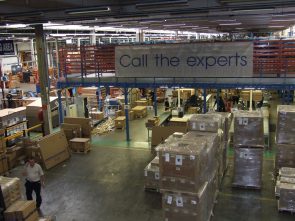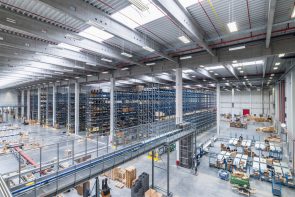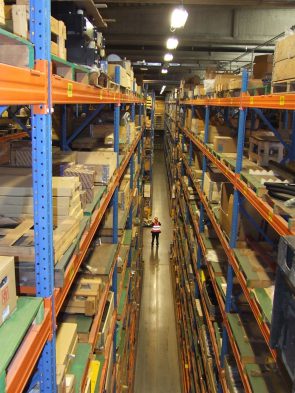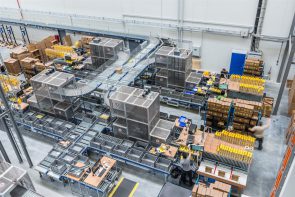Time is still money in the construction equipment sector
First published in Global Report: Construction Equipment 2016 as Time still means money
Increasing pressures and changing market needs mean it is time to make the construction equipment supply chain more agile and responsive – Adam Hill writes
Logistics is all about money. If you cannot get the right construction equipment and materials in the right place at the right time – at the right price – your project will fail as costs spiral out of control. Big infrastructure programmes need a tight chain of construction equipment owners, investors, designers, constructors, suppliers, financiers, engineers, maintenance staff and spare parts delivery networks to keep everything on the move.
Greger Lundesjö, in last year’s report Supply Chain Management and Logistics in Construction, outlines three major challenges: the challenge of place; the challenge of complexity; the challenge of achieving higher levels of sustainability.
Although there are many others, these three “profoundly influence the need for excellent construction logistics management”.
The choice is simple: if your customers cannot get what they need from you, they will go somewhere else. Jim Owens, former chairman and CEO of Caterpillar, said: “In our industry, the competitor that’s best at managing the supply chain is probably going be the most successful competitor over time. It’s a condition of success.”
Dangers of fragmentation
The provision of equipment such as bulldozers, concrete mixers, cranes, dump trucks, earth movers, excavators – and their parts – is a crucial part of the construction supply chain. But perhaps not surprisingly, given that such a diverse range of elements needs to come into play, things do not always run smoothly.
A 2013 report for the UK Department for Business, Innovation and Skills found that “construction supply chains are highly fragmented, and furthermore, that the level of fragmentation increases in supply chains that are directly involved in the delivery of construction work on site”.
This is a major problem for several reasons, Supply Chain Analysis into the Construction Industry found: “The implications of a fragmented supply chain include relatively high transaction costs, increased requirements for management input and co-ordination of activities on site, and fewer opportunities to drive out waste or reduce cost.”
Today’s supply chains are, by necessity, complex and many companies leverage their scale to keep customers satisfied. Komatsu America, for example, sources its machines worldwide, allowing it to respond swiftly to fluctuating demands on its own patch. This mixture of local and global sourcing is efficient and clearly works for the Japan-based firm.
However, there are many pressures on the supply chain and getting it right is not always easy. One fundamental issue remains above all. As Building the supply chain of the future, a 2011 McKinsey report, puts it: “Many global supply chains are not equipped to cope with the world we are entering.” It advocates “ditching today’s monolithic model in favour of splintered supply chains that dismantle complexity”.
A changing world
It puts forward several plausible reasons for this. As well as traditional concerns over bumpy trading conditions and cash flow, there are “other shifts, such as those associated with the developing world’s rising wealth and the emergence of credible suppliers from these markets, [which] will have supply chain implications for decades to come”.
Companies are certainly responding: at last year’s INTERMAT, South African hauling giant Bell revealed that its new logistics hub in Alsfeld, Germany meant that customers will receive their replacement articulated dump truck parts quicker than before. The centre is to be 12,000m², compared to the current 7,000m² facility on an adjacent site.
“It’s on the cusp of two north, south, east and west autobahn crosses in Germany,” explained Marc Schürmann, Bell’s Europe managing director. “The location is almost right in the centre of Germany. It’s an hour’s drive from Frankfurt, so we can have a parts pick-up late afternoon, get it on the plane at night, and deliver it to the customer or dealer the very next morning.” The hope is that this will be a 24-hour operation.
Expanding globally
Meanwhile, JCB World Logistics took over the former 35,500m² Blue Planet warehouse in Newcastle-under-Lyme, UK in July 2013 and has since tripled manpower levels to more than 300 as the facility becomes fully operational. JCB World Logistics, run by global logistics partner DHL, is the central receiving hub for supplier-bought components used in the manufacture and assembly of JCB machines.
“As JCB’s worldwide logistics partner, we wholeheartedly share their vision to expand faster globally,” said Paul Dyer, managing director of Automotive at DHL Supply Chain UK & Ireland.
DHL knows whereof it speaks. The company itself identified what it believes will be an increasing move towards regionalisation in the supply chain. In its report, Building the World, DHL suggested that construction equipment was one of the areas which would be most affected by changing consumer demand, compliance issues, skills shortages and new technologies.
“Engineering and manufacturing (E&M) companies are getting ready for fundamentally new and competitive market conditions over the next 10-20 years,” the report says.
Re-engineering production and business models to become more customer-centric and competitive is, therefore, a matter of some urgency: a broader and customised product portfolio, a wider range of different parts, more suppliers and the individual requirements of new markets will demand change.
Switch to regional
For the supply chains of the future, speed to market and the ability to react quickly to changes in customer demand will be crucial. This will require “a global network of more regionalised supply chains closer to markets and customers”, DHL suggests.
The rise of economies such as India and China will mean that production facilities will continue to gravitate eastwards – not just to take advantage of cheaper labour rates in developing countries, but to take advantage of proximity to a burgeoning number of consumers too.
DHL’s research found that, as well as these two BRIC countries, companies would be expecting to find more business in the MINT countries: Mexico, Indonesia, Nigeria and Turkey. The report found that most E&M companies are planning to supply those markets mainly from their facilities in China and other emerging countries: the fact that there is some similarity in those regions in terms of requested product quality and market structure will help, it believes.
However, this sort of upheaval presents real headaches for operations managers. McKinsey believes there is now a greater risk than ever for supply chain planners “of making key decisions that become uneconomic as a result of forces beyond your control”. Spreading the risk in this context makes a lot of sense as companies split their traditional lengthy chains into smaller units which can react more quickly to higher levels of complexity.
Getting a helping hand
DHL suggests that leading manufacturers “are increasingly applying an anticipatory support model”, managed by a lead logistics provider (as with its own JCB deal). A good example of this is Neovia Logistics’ five-year contract with Hitachi Construction Machinery Europe (HCME) to manage its warehouse operations, transportation and distribution of Hitachi machinery spare parts in Europe. Starting in 2015, Neovia took over the logistics base in Oosterhout, Netherlands to serve HCME’s customers. Pascal Born, Business Development Director of Neovia says that the company is particularly well placed to do this, having both an OEM background and the flexibility that comes with being a third party provider. “We can provide HCME with the differentiated service levels they require, leading to higher customer loyalty at lower costs,” he says.
For Moriaki Kadoya, President, CEO & Chairman of the Management Board of HCME, the deal is all about meeting and exceeding customers’ needs. “We are confident that through their expertise and experience, we will be able to take our spare parts business to the next level,” he said. It is an interesting phrase: increasingly companies are realising that they do need to take their supply chain to a new level and may require help to do so. This is because, as the DHL report suggests, warehouses will no longer necessarily be about managing stock alone. “Final assembly could be done here or in the distribution centre with in-house or logistics service providers enabling product customisation late in the production process,” it suggests. Technological advances such as 3D printing could also play their part in boosting responsiveness, with spare parts which are not used frequently being produced on-demand, on-site – leading to shorter lead times and lower inventory levels.
The rise of big data
While supply chain requirements may be becoming more complex, there is at least more help available in the shape of a previously unknown breadth of information.
 Fast parts deliveries are possible to Komatsu’s customers due to the Komtrax system fitted to machines, which provides alerts when service schedules are due and allows component kits to be prepared in advance
Fast parts deliveries are possible to Komatsu’s customers due to the Komtrax system fitted to machines, which provides alerts when service schedules are due and allows component kits to be prepared in advanceCaterpillar has latched on to the rise of Big Data by forming a new Analytics & Innovation division which will create a platform that takes massive amounts of data, combines it with data science to understand patterns and “quickly deploys information to save customers money, optimise performance and prevent unplanned downtime”. “We know that technology and information are the drivers in almost every industry including ours,” says Rob Charter, Caterpillar group president with responsibility for the Customer & Dealer Support division. “We have to continue pushing our company to be innovative – to imagine, create, and embrace the new and the different, and to be disruptive in our own way.”
Charter sees a huge opportunity for competitive advantage in the supply chain through analytics. “We have a unique opportunity to connect data from the broadest product line that cuts across multiple industries,” he says. “We can transform the mountains of incoming data – from a single machine or engine, an entire job site, the supply chain, a shipping location and much more – into valuable information for our customers and suppliers more efficiently and effectively than anyone else.”
Once again it is an acknowledgment that getting the supply chain right is the key to growth – and using the most advanced technological means of achieving that makes financial sense. DHL sees these sorts of collaborations as a sensible move, citing agricultural equipment manufacturer Deere & Company’s tie-ups with IT firms as an example which the construction supply chain may follow as it seeks to evolve.
A brighter future
There are a variety of different ways to manage the supply chain – and it is true that each project will bring different challenges anyway – but the crucial point is that older ways of doing things, in most cases, are probably not fit for purpose as patterns of consumption and production change.
BIS’s analysis indicates that a high proportion of cost in the supply chain is related to sub-contracted plant and machinery, some of which is self-delivered through subsidiary plant hire businesses. While this pattern of procurement might make sense in terms of a company’s tax strategy or strength of balance sheet, BIS warns that it may not be the way to achieve optimum plant utilisation.
Companies which can offer customers greater utilisation and efficiency will therefore be putting themselves into a good position – a state of affairs which offers much food for thought.
In his report, Greger Lundesjö sees hope for the future. “Construction logistics management is improving all the time and the construction industry has devoted considerable efforts to devising solutions to these problems,” he said.
Some observers have suggested that, in its thinking and its use of technology such as building information modelling (BIM) the construction supply chain is 10-15 years behind those of other industries such as automotive or aviation. But Lundesjö believes the next few years are “very promising in terms of the scope to apply new tools such as BIM to this field”.
As the McKinsey report suggested, the ability of supply chains to withstand a variety of different scenarios has the potential to influence the profitability and even the very existence of organisations. “In light of this, companies should design their portfolios of manufacturing and supplier networks to minimise the total landed-cost risk under different scenarios,” the report says. “The goal should be identifying a resilient manufacturing and sourcing footprint – even when it’s not necessarily the lowest-cost one today.”
That question of cost is a significant one: no-one likes to pay more than they need and it is likely to require a major shift in thinking from senior management in response to what is happening – or perhaps going to happen – on the ground. That may be easier said than done. But there is no doubt that the commercial prizes for getting it right are worth the effort.
Case Study 1: Volvo loose attachments hub
In 2012 Volvo Construction Equipment (CE) opened a hub on the outskirts of Ghent in Belgium, dealing with loose attachments such as buckets and couplers for the group’s excavators. Serving the whole of Europe, it was developed as part of Volvo CE’s Attachment Processes and Systems project, and has resulted in a “considerable reduction in lead times for customers”, the group says.
Among the improvements are a simplified order process, strong availability – 1,800 different items can be ordered and almost 900 units are in stock – and of course quicker service. Time is certainly money, and before the hub became operational customers were looking at delivery times ranging from eight weeks to three months for individually supplied attachments. Now, it is just one week for most orders, two to three weeks for loose attachments for compact wheeled loaders or excavators and four weeks for large wheeled- oader attachments. But this is more than just a question of keeping customers happy – for Volvo CE the improvements to its supply chain are a key plank in future business growth. It no longer makes sense to supply attachments with machines direct from Volvo CE production facilities: far better to have a dedicated, cost-efficient transport hub, complemented by a modified dealer portal and simplified ordering process. Once an electronic order is placed, the availability of the loose attachment in question is established and the Volvo CE dealer is informed of the lead time. Non-stock items are despatched from the supplier and consolidated at the hub, with deliveries made to regional dealers or direct to customers themselves.
Case Study 2: Liebherr spare parts for earthmoving equipment
Last year, Liebherr opened a new global logistics centre for its Earthmoving Equipment division at Oberopfingen in Germany. The facility allows spare parts for wheeled and crawler excavators, wheeled loaders, crawler tractors and other earthmoving machines to be managed from a new central location for customers all over the world – and the company says other construction machinery divisions are set to follow. “Our customers now get their spare parts faster,” explains Martin Barth, managing director of Liebherr-Logistics. “This important step guarantees that we will remain competitive in the future.” Until 2013, the management of spare parts supplies was more decentralised.
In view of the growing product range and increasingly complex material flows, Liebherr decided to centralise its system, initially organising it from smaller, existing warehouses. The new facility has space for about 100,000 different spare parts, which are taken into and out of stock by energyefficient operating machines. The company reckons it can now ship 1,600 individual orders to many European countries – almost all of them on the day the order is received. Location was, of course, important for the new complex: it is next to the A7 autobahn, near the major production site for Liebherr earthmoving machines at Kirchdorf an der Iller and relatively close to construction machinery and components divisions in France, Austria and Switzerland.
The site should eventually grow to 360,000m² – from 47,000m² at present – in an attempt to future-proof the group’s logistics processes as it plans to merge the spare parts logistics of other construction machinery divisions in Oberopfingen.
Companies in this article
Caterpillar
Liebherr
Hitachi
Volvo CE
Komatsu








